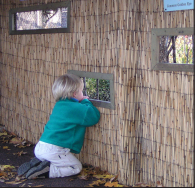BENEFICIAL LANDSCAPES
The things we love we try to pass on. For many of us, and maybe especially for gardeners, birdwatching is one of those interests. It’s easy and inexpensive to do, can be done almost anywhere, gets you outdoors, helps you focus and can be inspiring and energizing.
If it’s a pleasure you want to pass on—and whether it’s to your own children, students, grandchildren, friends or neighbors—here’s a few tips.
WHEN AND WHERE
● Early morning or at the end of the day is when birds are most likely to be active and looking for food.
● Spring and fall migrations involve much greater numbers of birds.
● Areas with lots of native plants are the most likely to harbor native birds.
● Transitional places encourage activity, places where habitat changes from one type to another, like at the edges of fields or forested areas.
● Areas with plants of varying densities at varied heights offer birds the best range of food and shelter… from groundcovers where insects are hiding to high outposts where they can readily see predators.
● Birds are attracted to dead trees, broken branches and other litter for nesting spaces and materials as well as burrowed insects.
● Places with accessible water.
● Home bird feeders and bird baths offer important supplemental food.
WHAT BIRD IS THAT?
For identification, help them learn to pay attention to things like:
● Color and placement of colors on the wings, breast and tail.
● Size—is it the size of a tiny hummingbird, small chickadee, medium robin, large hawk, eagle or heron?
● Shape—is it slender or fat, how long are the legs and tail, is there a crest on the head?
● Behavior—movement on the ground and in the air, how they perch or climb on trees?
● Song—does it sound like particular words or melodies?
RESOURCES AND RECOMMENDATIONS
● Binoculars can be difficult for kids to use, but low magnification ones can help them take a closer look at birds and their nests. Have them locate the bird first with their bare eyes and then raise the binoculars to that level.
● Journals or sketchbooks can help them record and illustrate their finds.
● Bird guides.
● Cameras to help with identification later on.
● Be quiet and careful and wear neutral clothes that won’t scare birds, and fabrics and shoes that won’t make noises when you walk.
● Don’t disturb nests, nesting birds or baby birds.
● Don’t go onto private property, don’t leave litter and try to stay on paths to avoid damage.
● Start them from what they know and where they are—common birds are a great place to start.
Organizations like Audubon, American Birding Association, Cornell Lab of Ornithology and many others, both local and worldwide, offer a wealth of birdwatching resources. With Nebraska being a major bird migration route for thousands of species, it’s a wonderful place for birdwatching this time of year and a great time to introduce kids to birdwatching on a grand scale.

